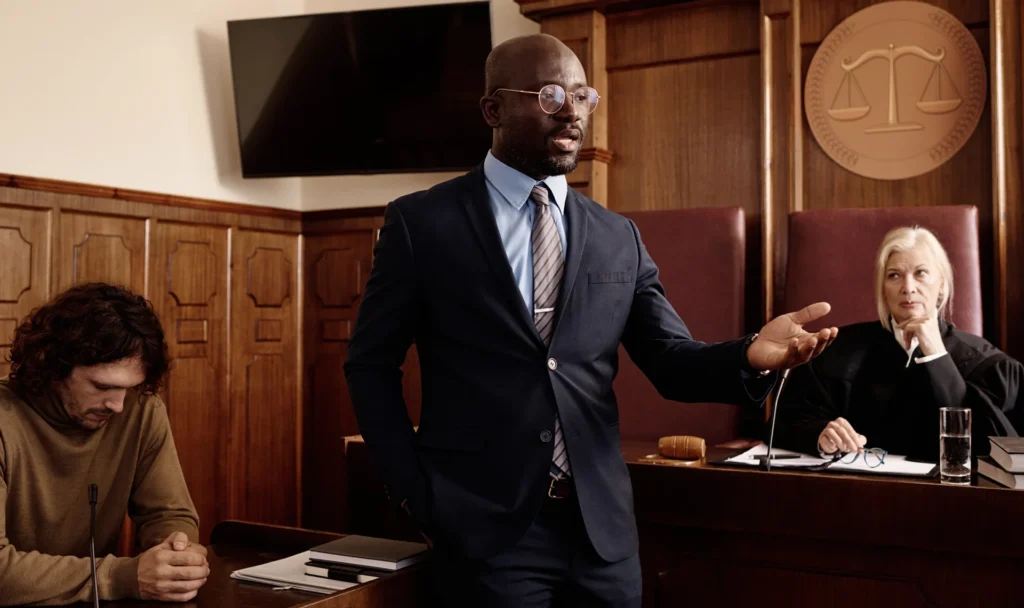Introduction
If you or someone you care about has been injured due to someone else’s negligence, you might feel overwhelmed by the thought of navigating a personal injury claim. The legal process can seem daunting, especially when you’re trying to focus on healing or supporting a loved one. Understanding the timeline of a personal injury case can bring clarity to this often complex process and help you know what to expect at every step.
From the initial steps after an injury to the resolution of your case, each phase of a personal injury claim plays a crucial role in securing the compensation you may be entitled to. Whether you’re dealing with medical bills, lost wages, or emotional stress, knowing the process can provide peace of mind and a clear path forward.
At Hurt Aid, we understand how challenging this journey can be. That’s why we’re here to guide you, connect you with trusted legal professionals, and provide the resources you need to move forward. This article outlines the typical timeline of a personal injury case, empowering you with the knowledge to take informed steps toward resolution and recovery.
Initial Steps After the Injury
The moments and days following an injury are critical, both for your health and for building a strong personal injury case. Taking the right steps early on can set the foundation for a successful claim.
1. Seek Immediate Medical Attention
Your health and safety should always come first. After an injury, whether it’s a car accident, slip-and-fall, or another incident, it’s essential to seek medical care as soon as possible. Even if you feel fine initially, some injuries may not show symptoms right away. A doctor can evaluate your condition and document your injuries, which is vital for your case.
Medical records serve as crucial evidence, demonstrating the extent of your injuries and connecting them to the incident in question. Skipping or delaying medical care can not only jeopardize your health but may also weaken your claim if the opposing party argues that your injuries were not severe or were unrelated to the accident.
2. Document the Incident
Gathering evidence at the scene, if possible, can strengthen your case significantly. Here are some key steps to take:
- Take Photos or Videos: Capture images of the accident scene, your injuries, and any property damage.
- Collect Witness Information: Get contact details from anyone who saw the incident happen. Witness statements can corroborate your version of events.
- File a Report: Whether it’s with the police, your employer, or a property owner, having an official report on record is essential.
Even if you were unable to gather evidence immediately, don’t worry—your attorney can often help you collect necessary information during the investigation phase.
3. Contact an Attorney
Navigating the legal complexities of a personal injury claim on your own can be overwhelming. An experienced personal injury attorney can evaluate your case, advise you on your rights, and handle the legal legwork so you can focus on recovery.
Most personal injury attorneys work on a contingency fee basis, meaning they only get paid if you win your case. This arrangement ensures that anyone, regardless of financial situation, has access to legal representation.
Connecting with the right attorney is crucial. They’ll help you understand your claim’s potential value, guide you through the timeline, and advocate on your behalf during negotiations or in court if necessary.
Taking these initial steps after an injury can make a significant difference in your ability to pursue compensation. Once these foundational elements are in place, the next phase begins: filing the personal injury claim.
Filing the Personal Injury Claim
Once the initial steps have been taken, the process of filing a personal injury claim begins. This phase is where your attorney formally sets the case in motion and begins advocating for your rights. Understanding the steps involved can help you feel more confident and informed about what’s ahead.
1. Case Evaluation
Your attorney will start by thoroughly evaluating your case. During this stage, they’ll review all the evidence, including:
- Medical records and bills.
- Photos and videos from the incident.
- Witness statements.
- Police or incident reports.
This evaluation helps your attorney determine the strength of your case, identify the at-fault party, and estimate the potential value of your claim. This value may include compensation for medical expenses, lost wages, pain and suffering, and more.
2. Drafting and Sending a Demand Letter
A demand letter is the first formal step in the claims process. This letter is sent to the at-fault party (or their insurance company) and outlines:
- The details of the accident.
- The injuries you’ve suffered.
- The financial losses you’ve incurred.
- A specific amount of compensation you are seeking to resolve the claim.
The demand letter serves as a starting point for negotiations. It’s carefully crafted by your attorney to make a compelling case for why the other party should compensate you fairly. Once the demand letter is sent, the ball is in the other party’s court to respond.
3. The Response from the Insurance Company
After receiving the demand letter, the at-fault party’s insurance company will typically:
- Review the evidence you’ve provided.
- Conduct their own investigation, which may involve speaking to witnesses or examining additional records.
Insurance companies often try to minimize payouts by challenging liability or downplaying the severity of your injuries. This is where having an experienced attorney is invaluable—they’ll counteract these tactics and ensure your rights are protected.
4. Deciding Whether to Settle or Proceed
At this stage, the insurance company might:
- Agree to the terms outlined in the demand letter and settle the claim.
- Offer a lower settlement amount.
- Deny the claim entirely.
If the settlement offer is fair, your attorney will help you accept it, concluding the case. However, if negotiations stall or the offer is insufficient, the next steps involve preparing for the possibility of a lawsuit.
Filing the claim is a pivotal point in the timeline. While it often leads to a resolution through settlement, it also lays the groundwork for further legal action if needed. In the next section, we’ll explore the investigation process, where attorneys and insurance companies gather additional evidence to strengthen their positions.

The Investigation Process
After filing a personal injury claim, both sides begin gathering and reviewing evidence to strengthen their positions. This phase, known as the investigation process, is crucial for building a strong case. Understanding what happens during this stage can help you feel more prepared for the journey ahead.
1. Insurance Company’s Review
Once the demand letter has been sent, the at-fault party’s insurance company will typically launch an investigation into your claim. Their primary goals are to:
- Determine liability: Who was at fault for the incident?
- Assess damages: What is the extent of your injuries and financial losses?
- Minimize payout: Insurance companies often aim to pay as little as possible.
As part of their investigation, the insurance adjuster may:
- Review the evidence provided in the demand letter.
- Inspect the accident scene, if applicable.
- Interview witnesses.
- Request additional documentation, such as medical records or employment history.
It’s important to be cautious during this stage, as the insurance company might try to use your words or actions against you to devalue your claim.
2. Attorney-Led Investigation
While the insurance company conducts its review, your attorney will also deepen their investigation to build the strongest case possible. This may involve:
- Gathering Additional Evidence: Your attorney might seek more medical documentation, expert opinions, or surveillance footage if applicable.
- Interviewing Witnesses: Speaking with people who saw the incident can help corroborate your version of events.
- Consulting Experts: In some cases, attorneys work with experts such as accident reconstruction specialists, medical professionals, or economists to strengthen the claim.
This stage is about building a comprehensive picture of what happened, the impact on your life, and why you’re entitled to compensation.
3. Communication Between Parties
During the investigation process, there is often ongoing communication between your attorney and the at-fault party’s representatives. This includes:
- Sharing evidence (in legal terms, “disclosure”).
- Clarifying liability issues.
- Discussing possible resolutions.
The goal is to establish a clear narrative and create a solid foundation for negotiations or, if necessary, litigation.
4. Evaluating Settlement Potential
Once the investigations are complete, both sides should have a clearer understanding of the case’s strengths and weaknesses. Your attorney will use the evidence gathered to negotiate with the insurance company, advocating for a fair settlement. If the evidence is overwhelmingly in your favor, this could lead to a swift resolution.
The investigation process is a behind-the-scenes but essential part of your personal injury case. It ensures all relevant information is gathered and analyzed to support your claim. If negotiations are unsuccessful, the next step is preparing for a potential lawsuit, which we’ll cover in the following
Negotiations and Settlement
After the investigation process, the focus often shifts to resolving the case without the need for a trial. Negotiations and settlements are common in personal injury cases, as they allow both parties to avoid the time and expense of litigation. This phase is where your attorney’s negotiation skills play a crucial role.
1. Settlement Discussions
Once both sides have reviewed the evidence, settlement discussions typically begin. During this phase:
- Your attorney will present your case, emphasizing the strength of the evidence and the extent of your damages.
- The insurance company may make an initial settlement offer, which is often lower than what you deserve.
- Your attorney will counteroffer and negotiate for a fair amount that fully compensates you for your medical bills, lost wages, pain and suffering, and other damages.
These discussions can involve back-and-forth communication, and your attorney will advise you on whether an offer is reasonable or if you should hold out for more.
2. Mediation: An Alternative to Trial
If negotiations stall but both parties are still open to resolution, mediation may be used as an alternative to litigation. Mediation is a structured negotiation process facilitated by a neutral third party, called a mediator. The mediator’s role is to help both sides reach a mutually agreeable settlement.
During mediation:
- Each party presents their perspective and evidence.
- The mediator facilitates discussions and suggests compromises.
- While the mediator cannot impose a decision, their input can often lead to a resolution.
Mediation can save time and resources compared to a trial while still achieving a satisfactory outcome.
3. Reaching a Settlement
If a settlement agreement is reached during negotiations or mediation, the terms are finalized in writing, and the case is resolved. A settlement avoids the uncertainty of going to trial and provides closure for both parties. Once the agreement is signed:
- The at-fault party or their insurer issues payment to you.
- In exchange, you agree not to pursue further legal action related to the case.
4. When Negotiations Fail
If the insurance company refuses to offer a fair settlement or denies your claim, your attorney may recommend filing a lawsuit. While many cases settle before reaching this stage, being prepared for litigation ensures you’re ready to pursue the compensation you deserve.
Negotiations and settlements are pivotal steps in a personal injury case, offering the opportunity to resolve the claim without the stress of a trial. However, if a fair settlement cannot be reached, the next phase involves taking the case to court—a process we’ll discuss in the following section.
If Negotiations Fail: The Lawsuit Process
When settlement discussions do not result in a fair resolution, the next step is to take legal action by filing a lawsuit. Although most personal injury cases settle out of court, understanding what happens during a lawsuit can help you prepare if your case progresses to this stage.
1. Filing a Formal Complaint
The first step in the lawsuit process is filing a formal complaint. This legal document:
- Outlines the details of the accident and your injuries.
- Identifies the at-fault party (the defendant).
- States the compensation you are seeking.
Once the complaint is filed with the court, it is served to the defendant, notifying them of the legal action. From here, the litigation process officially begins.
2. The Discovery Phase
Discovery is the phase where both sides exchange information and gather evidence to build their cases. This process includes:
- Interrogatories: Written questions that each party must answer under oath.
- Depositions: In-person interviews where witnesses, including you, provide sworn testimony.
- Requests for Documentation: Sharing medical records, accident reports, and other relevant documents.
Discovery ensures that both parties have access to all necessary information to present their case. It can be a lengthy process, but it’s critical for preparing a strong argument.
3. Pre-Trial Motions
Before the trial begins, either party may file pre-trial motions. These motions aim to:
- Resolve the case before trial (e.g., a motion for summary judgment if the facts are overwhelmingly in one party’s favor).
- Limit evidence or testimony during the trial.
- Clarify legal issues.
Pre-trial motions can significantly impact the direction of the case and even lead to a resolution without going to trial.
4. Settlement Talks Continue
Even after a lawsuit is filed, settlement discussions often continue. The discovery process may reveal new evidence that encourages one side to reconsider their position. Many cases settle at this stage, avoiding the need for a trial.
5. Preparing for Trial
If no settlement is reached, both sides prepare for trial. This preparation includes:
- Finalizing witness lists.
- Creating opening and closing arguments.
- Strategizing the presentation of evidence.
Your attorney will guide you through this process, ensuring you are ready for what to expect in court.
While the lawsuit process can seem intimidating, it’s often a necessary step when negotiations fail. Having a skilled attorney by your side can make all the difference, helping you navigate this phase and advocate for your rights effectively. The next step in the timeline is the trial itself, where a final decision will be made about your case. Let’s explore what happens during the trial and verdict phase.
Trial and Verdict
When a personal injury case proceeds to trial, it marks the final phase in the legal process. This is where both parties present their evidence and arguments in court, and a decision is made regarding liability and compensation. Although the prospect of a trial can be intimidating, understanding what happens during this phase can help you feel more prepared.
1. The Trial Process
Trials in personal injury cases typically follow a structured format. Here’s what to expect:
- Jury Selection: In cases tried before a jury, both sides participate in selecting impartial jurors. This process ensures that the jury is fair and unbiased.
- Opening Statements: Both attorneys present an overview of their case. The plaintiff’s attorney (yours) outlines how the injury occurred, the damages suffered, and why the defendant is liable. The defense attorney responds with their version of events.
- Presentation of Evidence: During this phase:
- Your attorney presents evidence, such as medical records, photos, videos, and expert testimony, to support your claim.
- Witnesses, including you and any experts, may testify about the incident and its impact on your life.
- The defense also presents evidence and witnesses to challenge your case.
- Cross-Examination: Each side has the opportunity to question the other’s witnesses to challenge their credibility or the strength of their testimony.
- Closing Arguments: Both attorneys summarize their cases, emphasizing key points to persuade the jury or judge.
2. The Verdict
After the trial concludes, the jury (or judge in a bench trial) deliberates to reach a verdict. They will determine:
- Whether the defendant is liable for your injuries.
- The amount of compensation you are entitled to, if any.
The verdict is based on the evidence and arguments presented during the trial. If the jury finds in your favor, they will award damages, which may include compensation for:
- Medical expenses (past and future).
- Lost wages and diminished earning capacity.
- Pain and suffering.
- Emotional distress.
If the verdict is not in your favor, you may have options to appeal the decision, which we’ll cover in the next section.
3. The Role of the Judge and Jury
In a jury trial, the jury decides on liability and damages based on the evidence. In a bench trial (where there is no jury), the judge makes these determinations. Your attorney will tailor their arguments to the specific audience, whether it’s a jury or a judge.
4. Post-Trial Actions
If the verdict is favorable, the at-fault party or their insurer will typically issue payment to satisfy the judgment. In some cases, the defense may appeal the decision, delaying the resolution.
If you do not receive a favorable verdict, your attorney can discuss the possibility of filing an appeal to challenge the outcome.
While a trial can feel like the most stressful part of the personal injury process, it is also where justice is ultimately sought. Your attorney will guide you through every step, ensuring that your case is presented clearly and effectively. If the trial concludes with a verdict in your favor, the focus shifts to post-trial actions, such as collecting compensation. We’ll explore this and the potential for appeals in the next section.

Post-Trial and Appeals
After the trial concludes, there are still important steps to navigate, regardless of the verdict. This phase focuses on collecting compensation, addressing potential appeals, and understanding the next steps for finalizing your case.
1. Collecting Compensation
If the jury or judge awards you damages, the next step is to ensure you receive the compensation. This process typically involves:
- Payment from the Defendant or Their Insurer: The at-fault party or their insurance company is responsible for issuing payment based on the judgment.
- Structured Payments: In some cases, compensation may be paid as a lump sum or through structured installments, depending on the agreement or court order.
Your attorney will oversee this process to ensure the payment is made in a timely manner. If the defendant fails to pay, legal enforcement measures may be necessary, such as wage garnishments or asset liens.
2. Appeals Process
If either party is dissatisfied with the trial outcome, they may choose to file an appeal. Appeals are not about retrying the case but rather reviewing potential legal errors made during the trial.
- Who Can Appeal? Both the plaintiff (you) and the defendant have the right to appeal the verdict.
- Grounds for Appeal: Appeals are based on claims that the trial court made mistakes in applying the law, allowing improper evidence, or other procedural errors.
- What Happens During an Appeal? The appellate court reviews the trial record and written arguments (briefs) from both sides. In some cases, oral arguments may also be presented.
An appeal can prolong the resolution of your case, but your attorney will advise you on whether pursuing an appeal is in your best interest.
3. Final Resolution
Once all post-trial matters and appeals are resolved, your case is officially closed. If you win your case, the compensation you receive can help you cover medical bills, lost income, and other damages, providing financial relief and a sense of closure.
For many personal injury victims, this marks the end of a challenging journey and the beginning of a new chapter focused on recovery and rebuilding.
4. Learning from the Process
The post-trial phase is also an opportunity to reflect on the lessons learned throughout the process. Whether you’re a victim or supporting someone who has been injured, understanding the legal timeline can be invaluable if similar challenges arise in the future.
Conclusion
The timeline of a personal injury case can feel overwhelming, but knowing what to expect at each stage helps you navigate the process with confidence. From seeking medical attention and filing a claim to negotiating a settlement or going to trial, every step is designed to pursue justice and secure the compensation you deserve.
Hurt Aid is here to support you throughout this journey. Whether you’re seeking guidance for yourself or researching on behalf of someone you care about, our platform connects you with trusted resources and experienced legal professionals. By empowering you with knowledge and access to the right support, Hurt Aid ensures that no one has to face the challenges of a personal injury case alone.





